Heart of peppermint-barkness: I infiltrated Hallmark town, changing my view of its holiday movies
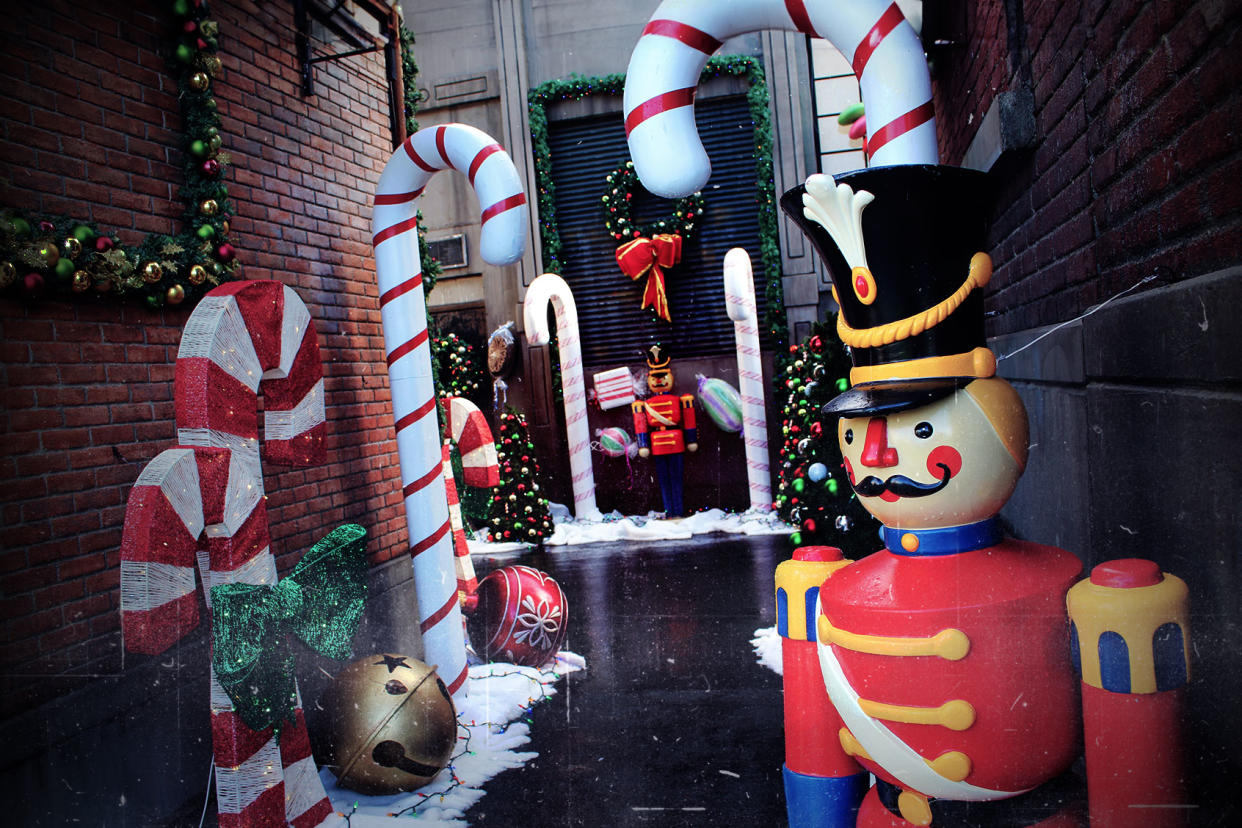
When my editor asked if I had an ugly Christmas sweater to wear, I knew she was only looking out for me. My assignment required me to infiltrate a Hallmark Channel hub just over the Canadian border called Martini Film Studios.
Once there I’d walk approximations of streets that could be part of a small town or double for Brooklyn, all decked out in evergreen garland, sparkling lights, giant candy canes and other holiday ornaments. Surrounding me would be the natural denizens of Martini Town, if such a burg existed, all eager to savor the lot’s first Hallmark Fan Experience.
A little knitted camouflage might come in handy, she thought. I had none and could only hope for the best – that the Hallmark Experience, held on the first Saturday in December, was as idyllic and welcoming as the channel’s movies.
What does it mean to be a Hallmark fan? As someone who only watches Hallmark Holiday Movies when her mother-in-law or a friend’s mom has it on in the background – mothers seem to be the channel’s main target audience – I did not know. My hope, and that of the editors who assigned me to cover the experience, was that I’d have a better idea of what that meant by the end of the day.
Martini Town’s Fan Experience welcomed 120 people, including me and The Husband, to spend the day with “Some of Your Favorite Actors!”
It did not disappoint. A few of the network’s favorite locally based stars, directors and producers – including Benjamin Ayres, Peter Benson, Paul Campbell, Antonio Cupo, Ali Liebert, Kimberley Sustad, and Victor Webster – met with their grateful fans. Later they shared their experience of working on Hallmark movies on a panel.
At one point Cupo spotted me and my spouse, who agreed to serve as my photographer, and walked over smiling brightly. “Want a picture?” he asked. I shocked myself by gleefully consenting. I also revealed that I was writing about the Experience, which made Cupo’s smile widen even more. Genuinely, in fact.
Cupo not only stars in many Hallmark productions, he also produces a few. Every star attending that day’s panel wears multiple jingling hats in the Hallmark Movie factory, whether performing in, directing or writing these movies. Hallmark’s main claim to fame is to provide an afterlife for network TV names like Lacey Chabert, Autumn Reeser and Lori Loughlin, pre-college admissions scandal conviction. Brandon Routh, who was Superman before Henry Cavill donned the cape, co-stars with Sustad in the 2014 feline favorite “The Nine Lives of Christmas.”
They work hard to make these distractions that help people take it easy at a hectic time. Although their devotees appreciate them, the average reporter might not.
Here is a fine time to confess that when Cupo slung his arm around my shoulders, jazzed to play his part in immortalizing this moment, I had no idea who he was.
But I did recognize Campbell from his role in “Battlestar Galactica,” in which he played Billy Keikeya, the chief of staff to Mary McDonnell’s President Laura Roslin. To this day “Battlestar” is beloved by critics. Campbell is featured in 25 episodes, his longest-running role in an American TV series. From there he had a main role in NBC's “Knight Rider” reboot, which is not remembered as fondly. He also appeared in “Supernatural,” a show that was to Vancouver performers what “Law & Order” is to New York actors.
A decade ago, when Campbell was given the chance to audition for his first Hallmark movie “Window Wonderland," he told the audience assembled for the fan panel, “I'll be completely honest . . . both my agents said, ‘You're not doing a Hallmark movie. They're not great. They're not right for you.’”
He continued,“And I said, ‘Let me read it’. And I read the script. And I was like, ‘You're crazy. This is fantastic’ . . . and I said, 'Don't ever tell me again what I shouldn't be doing.' I haven’t looked back, honestly.”
Campbell’s Hallmark credits include, but are not limited to, “Holiday Hearts,” “Once Upon a Holiday,” “A Godwink Christmas” and “The Santa Stakeout.” But his choreographed dance in “Three Wise Men and a Baby” floored the audience, proven by their wild whoops at his mentioning the title. Then again, the crowd cheered and applauded at the mention of every Hallmark title, elated to have their memories sparked.

Hallmark's holiday lineup is an annual cultural force, seen by enough people this year to make the channel the most-watched cable entertainment network in 2023 in total day audience averages, according to Nielsen. Ayres' latest, “Miracle in Bethlehem, PA,” debuted as Thursday's most-watched entertainment program on primetime cable, drawing 1.9 million viewers to Hallmark Movies & Mysteries, which my friend and colleague Josef Adalian shared in an X post.
Joe, Vulture's West Coast editor and resident TV data expert, has long sung Hallmark’s praises. In November he examined Hallmark’s ratings durability at a time when most non-news cable channels are hurting for live-plus-same day viewers. Between the main channel and Hallmark Movies & Mysteries, the company rolled out 40 original holiday movies in 2023.
It can do this, he explained, because a healthy portion of its nearly 70 million cable subscriber base still shows up to watch its content on linear TV – this, at a time when the cable model is shrinking and more viewers are cutting the cord.
“It’s not uncommon for Hallmark to have the most-watched entertainment program in all of cable on a given night, especially during the holiday season,” he wrote. “In many ways, Hallmark is TV’s last great basic cable channel.”
When I let Joe know I’d gotten this assignment, he expressed genuine pleasure at the news, urging me to have some cider and cocoa for him.
“Mainly telling you so that if I disappear you know what to tell Dateline,” I messaged back.
“Lololol if you disappear, I will know it's by choice because you joined the Hallmark cult!!” he replied.
We’ll see about that.
I am the farthest thing from a Christmas enthusiast, solely due to end-of-the-year burnout. The Husband is slightly more into the season, dutifully trudging out to the local hardware store the weekend after Thanksgiving to pick out a tree that he decorates by himself while I slump on the couch nearby, occasionally murmuring, “Good job.” Our holiday movie marathon tradition stars “The Long Kiss Goodnight,” “Bad Santa,” Peter Jackson’s “Lord of the Rings” trilogy and maybe “Krampus.”
We are not the target audience for, say, “Lights, Camera, Christmas!” or “A Tale of Two Christmases” or “Friends & Family Christmas,” all of which were filmed in part on the Martini Studios backlot. That makes me one of the least qualified on our staff to journey into the heart of peppermint bark-ness and Christmas tree lots.
But I am probably more game than my colleague Amanda Marcotte, whose story “Hallmark movies are fascist propaganda” drew the ire of no less than one of the network’s favorite sons Dean Cain when it was published in 2019.
Marcotte’s piece resurges in popularity every December since then, Salon’s seasonal equivalent of what “The SantaLand Diaries" was to NPR two decades ago.
In the same way David Sedaris gamely signed up to be a Macy's elf for a season, I agreed to submerge myself in Hallmark culture for one Saturday – willingly, if not entirely eagerly. After all, I too have entered my share of critiques about Hallmark’s insistent whiteness under its previous president and CEO Bill Abbott.
Contrary to most old-school Hallmark movie heroines, you see, I’m already married to a guy from a smaller Midwestern city who reminds me every year that Christmas is happening.
That doesn’t mean he was pumped to drive to Canada at 8 a.m. on a Saturday for any reason that didn’t involve goofing off in Vancouver. “Let’s do this,” he growled, handing me a to-go mug full of coffee as he slid into our car's driver’s seat and turned over the engine.
It was only when we got on the highway and I took the first sip that I realized he'd spiked my caffeine with seasonal cheer. “Is there . . . Bailey’s in this?” I asked. Remember — it was not even 9 a.m.
“Only yours,” he said. “You’re welcome.
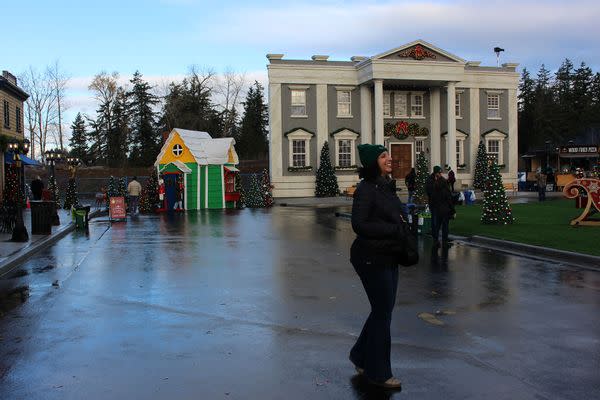
The Hallmark many Salon readers know is the Hallmark that in 2019 pulled an ad featuring a lesbian couple kissing at their wedding ceremony, caving to pressures from a conservative group of joy-killers, aka One Million Moms, aka the American Family Association, which the Southern Poverty Law Center designates as a hate group. Hallmark reversed its course in short order, mainly in response to the larger public’s decrying that decision and calling B.S. on the company’s excuse that it doesn’t show any ads featuring "overt public displays of affection . . . regardless of the participants."
But that lame reasoning isn’t surprising from Abbott, who told me in 2016 that Hallmark’s lack of diversity was because casting directors had a Dickens of a time find non-white actors in Canada.
Abbott was replaced in mid-2020 by Wonya Lucas, who made increasing diversity a main goal as the CEO of Hallmark Media. Lucas left that position this year although, according to the company, she continues to serve on the Hallmark Media Board of Directors. During her tenure, Hallmark's lineup has noticeably featured more inclusive casts, including gay couples, disabled main characters and non-white leads who aren’t relegated to the BFF zone. Even so, the channel's competition has been way ahead of them in that department for some time. In 2020, for instance, Broadway star Ali Stroker became the first wheelchair user to star in a holiday romance with her leading role in Lifetime's "Christmas Ever After."
Since the Hallmark Channel model revolves around airing holiday films non-stop between mid-October and the New Year, the changes it has made won’t necessarily be apparent to anyone who might look up the channel on a whim. During the hours outside of primetime you’re more likely to encounter content from Hallmark’s Endless White Christmas era, confirming every punchline at the channel’s expense.
In case you're not familiar with what this refers to, and because it’s funny, you might also read about them in Salon Chief Content Officer Erin Keane’s 2018 commentary:
Overwhelmingly white and Christian, these movies dramatize the attainment, after the requisite miscommunications and crises of faith, of a specific American suburban fantasy that seamlessly blends the following ingredients: a nonthreatening career that never demands evening and weekend work or relocation; a heterosexual marriage to a handsome employed man who values family, with at least one child guaranteed; and a palatial suburban home located within walking distance of one or both sets of parents, surrogate or real.
Hallmark Media’s executive vice president of programming Lisa Hamilton Daly has heard all those jokes and more, both as a leader at the network and its one-time competitor. Before joining Lucas’ team in 2021, Daly worked at Netflix and Lifetime. And yes, she’s aware of the fascist propaganda parallels drawn by my coworker lo those many (ok, like, four) Christmases ago.
“The minute there’s a new Hallmark parody, someone sends it to me, very helpfully,” Daly told Salon in a recent Zoom interview. “Look, there's a long history here at Hallmark. And for a long time, I think that people felt that the audience was finding comfort in watching the exact same thing over and over and over again.”
Daly doesn’t intend to challenge the core of that successful model, pointing out that the holiday season calls for traditions everyone returns to regardless of their culture or belief system. Hallmark’s movies boil down to a predictably happy outcome, she says.
“What I think we're trying to do a little differently is, who's having a happy outcome? . . . And I think this year, and over the last few years, if you really look at what we've done, we still have that core of emotion. You still have a happy ending. But I think the way that we get to that happy ending can be a little more sophisticated.”
What that means, she explains, is that Hallmark productions are broadening beyond the heteronormative girl-meets-boy-at-the-tree farm stories. Hallmark still has those, she says, and they’re an important part of their repertoire.
“I closely monitor social media,” she says. “So I see a lot of the criticisms as well as what people are happy with. And what I've seen a lot of is that people see themselves, they're happy to see themselves, they see their friends, and they still know it's going to have a feel-good aspect.”
And the truth is, these movies have a place in many households' holiday traditions. Have for years, even when Hallmark was at its least inclusive. I recently spoke with Yvette Nicole Brown, who has plenty of experience with holiday specials through her role in “Community.”
She associates Hallmark movies with the memories of her mother, who passed away two years ago.
“She loved Lifetime and Hallmark movies. From, like, Nov. 22 to Jan. 3, all she did was just watch them,” Brown said. “And it’s the same story. Somebody came home, and they’re tearing down the Christmas tree lot. And they have to be at a Christmas social on the weekend, where somebody wins the prize. If they don’t everybody’s gonna lose the town. And that cute guy that used to wear glasses loves her.
“Same story,” she concluded, “but it's delightful. And it works because it's a great story. But yes, I do enjoy them.”
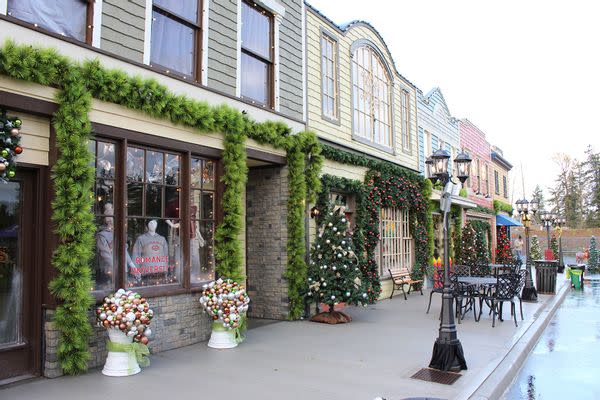
Langley, the British Columbia township where Martini Film Studios occupies 250,000 square of soundstage and support space, along with a 150-acre forested back lot called Martini Acres, is farm country. Rolling down our car windows at the border crossing provided fragrant confirmation of its status as the horse capital of British Columbia. Visual proof came with the drive passing green fields and paddocks, affording glimpses of some of the backlot's many equine neighbors.
Martini Town, however, might as well have been a snow globe celebrating Picturesque Christmasville, U.S.A. Hallmark movies are shot in a variety of places around Canada, the U.S., and Europe, but you could ask for no better living example of what these movies romanticize than this.
Its monthlong Holiday Merry & Bright event is set on six acres arranged in a variety of very Hallmark backgrounds, including a Romance University gift shop, a fake courthouse with stately columns, a movie theater with an old-fashioned marquee, and a funeral parlor gladdened by a silver wreath on its door.
A street lined with artificial brownstones to resemble a New York borough is the main sign that the place sometimes provides a stamp-sized view of city life. At the center, a few steps away from the Martini Town Christmas tree, is the lot’s version of the hallowed Hallmark gazebo. Standing still in the midst of all that allowed me to feel the infectious joy buzzing in the air. Strangers weren’t simply nice, they were welcoming.
When I accidentally bumped a woman and begged her pardon she gently replied, “No apologies needed, friend!” Canadians are notoriously polite, but this was another level. It also was sunny that day in Langley, with temperatures hovering around 50 degrees. Mild winter days bring out the best in everyone. The glittery, nostalgic surroundings only amplified that. My spouse was smiling. How could he not? Even the alleys looked inviting, with adult-sized nutcrackers casually loitering there instead of the usual muggers.
Snow gently piled on window sills and in corners didn’t melt, revealing one piece of trivia most Hallmark aficionados have long known. Most of the frosty stuff you see in their movies is made of cotton-like batting.
Once you’re knee-deep in it, resistance to the Hallmark holiday movie spirit is futile.
If you’re picturing the Hallmark Fan Experience to be something akin to BravoCon in New York City which offered, among other escapades, a Real Housewives Museum featuring exhibits such as one of the star’s breast implants, then you don’t know this audience. The Hallmark Experience panel provided a window into filmmaking techniques and scriptwriting instead of prodding attendees to hoot at debauched moments caught on camera. (This is Hallmark we're talking about — there are no such things.) People were invited to submit questions, and most asked about the possibility of sequels or other choices.
BravoCon hawked cocktails. The Hallmark Experience offered attendees cocoa and comfort food for lunch, where the choices were artisan-style pizzas or a selection of items from a barbecue vendor, including loaded baked potatoes, melt-in-your mouth brisket, and macaroni and cheese.
Martini Film Studios founder and CEO Gemma Martini bustled about unobtrusively, making sure the talent was where they needed to be and, above all, that the attendees were happy. In a series of emails with Salon, she explained that this Hallmark Fan Experience is the first she’s produced, along with the monthlong Merry and Bright event that she says averages around 3,000 visitors per night.
Martini was inspired to open the lot to the public after observing other fan experiences. “I felt that we could do a better job of serving and engaging the fans,” she said. With her monthlong holiday festival already planned, “What could be better than a fully decorated Christmas Town where the movies had been filmed?”
Since the Martini Studios lot was built out in 2020 to accommodate the production of Netflix’s Grendel – it was also used for the second season of Apple’s “Schmigadoon,” and for many commercials, Martini said – it has hosted 19 Hallmark movie productions.
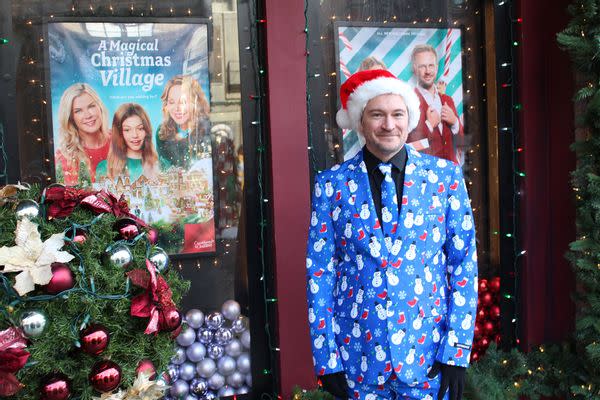
Hallmark has long had a presence around the Vancouver area and British Columbia, where the actors featured on the panel are based. The crowd that showed up for the Fan Experience was mainly local too, and reflective of the average Hallmark movie viewer. That is to say, women aged over 50. Not all – one of the day’s most unmissable attendees was Craig Ewing, who wore a blue Christmas-patterned suit and tie for the occasion. Ewing and fellow Vancouverite Lisa Alguire made the trek to Martini Town with their friend Alanna Schier, who joined them from Victoria, B.C.
Not every Hallmark holiday film is made in Canada these days. “A Biltmore Christmas” was filmed in Asheville, North Carolina at the Biltmore Estate, an example of the company’s expanding its productions beyond Canada. “Christmas in Notting Hill,” as the title suggests, was shot in the U.K. and Ireland.
For Ewing, Alguire and Schier, the location matters less than the uplift they offer. “They’re just easy to watch,” Ewing said. “You know, you start with a nice basic concept. You kind of know what's going to happen.”
As for the critiques Hallmark has sustained related to its thematic homogeneity, Ewing simply shrugs it off. “It's just like watching a TV series, right? You watch a TV series for a specific reason because you're going to get something out of it. Go way back to say, watching ’24.’ You know there's going to be tension and drama. Well, these are the exact same thing — different movies, but it's the same feel, and you know you're going to feel good by the end of it.”
Does strolling beside obviously fake snow in person melt any of the magic? “You know what? No. When I look at movies, being from around here, I can tell it's fake snow. You’re from around here, so you know that when you start pushing snow aside it gets a little bit brown. You don’t see that in Hallmark movies, so you know it’s fake snow.”
Another smidgen of realism you won’t see in Hallmark movies is warm breath misting on cold winter breezes. Most of their holiday films are filmed between August and October. (Martini said her studio site was busy in June of this year “because of the expected actors strike,” work that was covered by Screen Actors Guild waivers.) Write off those simple stories all you like, but when you realize these actors are making you believe you’re watching a midwinter tale despite it having been shot in the dead of summer, you can’t accuse them of not plying their craft.
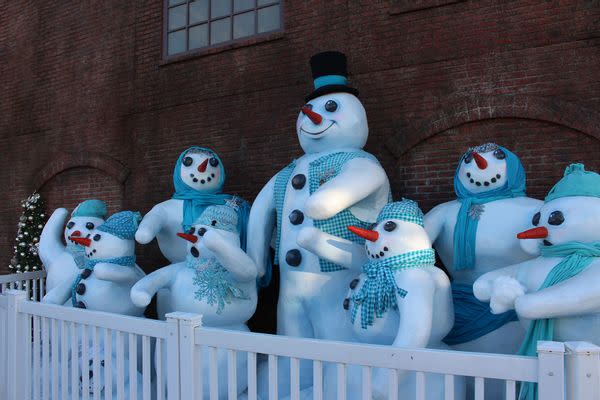
The panel discussion revealed a lot about how the sausage is made, but it didn’t get much more dramatic than Campbell and Peter Benson recalling how filming “The Santa Stakeout” in 2021 dangerously wilted Campbell’s co-star Joe Pantoliano.
That’s because they were inside of a barn in full winter weather getup – scarves, hats, the whole ball of wool – during the record-setting heat dome that dangerously cooked the Pacific Northwest. The air conditioning unit they’d ordered from another set had not been delivered.
“It was a real problem,” Campbell said.
“No, it was actually scary,” said Benson, who can still remember Pantoliano slumping over while dressed in a complete Santa suit. “I was like, ‘We just killed Joey Pants.’ It felt like an episode of ‘The Sopranos,’” he joked. But they also felt for all the background performers who have to wear layers and stand around between takes.
Then, Ayres said, “Right before you say ‘Action,’ you're like, ‘And remember, it's cold. You're freezing. And happy!”
Fan cultures arise around any popular entertainment franchise, and certainly Hallmark qualifies. During the panel some asked Liebert and Sustad to reveal what they do with their assorted Hallmark coats, which is apparently an obsession among regular viewers. Each was wearing one from a recent production that day.
As the stars traded anecdotes, it became clear that they know each other and frequently work together. Martini, too. In her life before founding a studio backlot, she co-starred with Cupo on a 2018 Lifetime movie called “Muse,” and has film credits stretching back to 2009 on her IMDb page.
This familiarity lent additional warmth and intimacy to the experience while also pointing to the reason that Lucas’ efforts to include more Black, brown, Asian and Indigenous talent in Hallmark productions aren’t merely a matter of window dressing. It can also lead to more employment for these performers in front of the camera and behind it.
In 2021, Samba TV found that out of all of Hallmark Channel’s Countdown to Christmas programming presented in 2020, only 17% featured a non-white lead. The only film that over-indexed for Black viewers by a slim margin was “Christmas Comes Twice” starring Tamera Mowry.
At the Hallmark Fan Experience, stars benignly joked about Lifetime the way the home team takes swipes at the competition, but Lifetime draws a more diverse audience by counterprogramming against Hallmark with holiday films featuring Black and other non-white leads. Other networks have followed suit, including OWN, Netflix, BET and VH1.
“For the longest time, there weren't films that had people that look like me,” Brown said in answer to my question about the changes to which Hallmark has committed. “I hope that they understand that it's the right thing to do. And nobody's hating on Hallmark. Hallmark has wonderful cards, and they put out really fun and romantic movies. We just want everybody to get to come and play, and if they’re righting that ship, God bless.”
Liebert's latest, “Friends & Family Christmas,” represents a turn of that wheel.
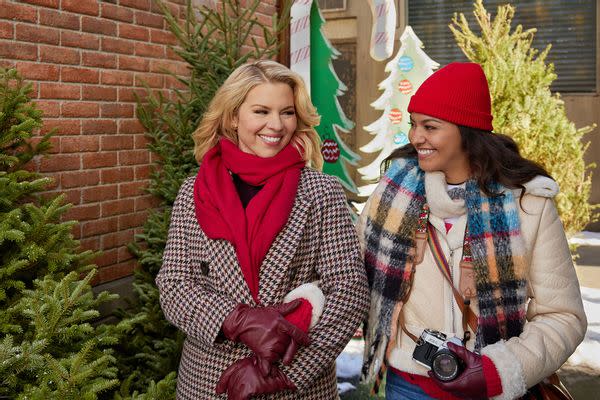
“Friends & Family” is the first Hallmark holiday movie featuring two women in the hero romance, casting Liebert opposite Venezuelan-born Canadian actor Humberly González. Their story is another version of a familiar tale, with two people set up by well-meaning but meddling families who simply want them to have love in their lives.
Want a daily wrap-up of all the news and commentary Salon has to offer? Subscribe to our morning newsletter, Crash Course.
Liebert’s Amelia is a high-powered attorney who buries herself at work to avoid dealing with her heartbreak over a broken engagement. González’s Daniella is an artist pouring her soul into a local artists’ collective. Neither believe they have anything in common, let alone time to get to know each other, but this is a Hallmark movie. Of course they figure it out.
The shift away from the old Hallmark way of doing things is visible in all corners of "Friends & Family." All of Daniella’s peers are young people of color. Several are queer. Since Daniella is too busy to go home for the holidays, her parents come to (the Martini Studios version of) New York to spend Christmas with her. Neither set of parents mentions anything about their child’s sexual orientation – they just want their daughters to be happy and find love.
“Friends & Family” is one film that evokes the new Hallmark philosophy Daly describes as being all-welcoming. Liebert believes it made it onto the schedule based on the success of last year’s “The Holiday Sitter,” a movie she directed that featured two men falling in love.
Speaking as a queer woman, Liebert said she’s heartened to see Hallmark back holiday romance movies that feature same-sex couples. Working with Hallmark has also given her a chance to build her resume as a director – she’s steered two other movies that premiered this year: “Christmas in Notting Hill” and “Time for Her to Come Home for Christmas.”
“I can't speak for Hallmark but for me, as a director and executive producer, that's when I have more contribution in the casting,” she said. “I’m always advocating for diversity and inclusion, and it’s my opinion that Hallmark is committed to increasing the different types of stories we tell.
“For sure, [“Friends & Family”] could have come a couple of years ago,” she added, “but we're here now.”
Asked for her opinion as to why Hallmark was so slow to change its repetitious plots and exclusionary casting practices, Daly generously surmised those decisions were based on who the Hallmark audience is and continues to be. Translation: women age 50 and up, according to data provided by National Media Spots. That demographic comprises more than 70% of the channel’s audience.
But that also means Hallmark has to begin building toward the future. “I think as we start to move further into the 21st century, we're looking with an eye towards like younger audiences, wider audiences. . . . And I would like to pull in everybody, right? That's my idea is to pull in everybody. So what stories do we tell that have had the widest appeal?”
Hallmark’s 2023 offerings include a few answers. There’s the Hanukkah-themed “Round and Round,” which plays upon the Groundhog Day device of having characters stuck in a time loop. One of the year’s best, “A Biltmore Christmas,” is a time travel romance that marries old Hollywood glamour with modern rom-com difficulties.
“Magic in Mistletoe” casts Black actor Lyndie Greenwood opposite Campbell. “Christmas with a Kiss” features a Black main cast, and “Holiday Road” is an ensemble road trip comedy featuring Black and Asian characters alongside Hallmark repeat players Sara Canning and Warren Christie.
Not all of these are romances, and few of the love stories follow the standard “career woman surrenders aspirations to the small-town Christmas spirit" model. Not that Daly apologizes for those.
“A lot of our audience are people like emergency room nurses, people with very stressful and traumatic jobs,” she said. “And they find real solace and comfort in watching movies where the world is ordered, where it feels comforting to be there, and familiar. And I never want to lose some of that element.”

The Hallmark Fan Experience wore us out, and once we’d returned home and traded in our jeans for pajama pants, we settled in for a double feature of “Friends & Family” and “Biltmore” – for the research, initially, and later, we forced ourselve to admit, for the pleasure.
Noticing the appearance of certain Martini Studios-rendered shop fronts and intersections in the former was, I’ll admit, kind of exciting. Knowing there would be no tragic endings, despite hints to the contrary, allowed me to sink into the couch cushions more deeply as the tension melted from my muscles.
A day at Martini Town hadn’t irrevocably changed me, understand. I am not a newly registered member of the Hallmark cult, as Joe hinted might happen. But I do have a better understanding of the passion its viewers have for movies assumed to be devoid of it and respect Hallmark's efforts to transform with the times. It’s just going to take a while for that evidence to emerge from under its back catalog's snowy avalanche.
"Friends & Family Christmas" encores Sunday, Dec. 24 at 9 a.m. PT/ noon ET and Wednesday, Dec. 27 at 6 a.m. ET.
